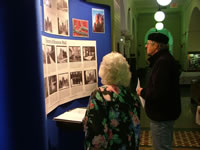
On October 11th over three hundred visitors representing more than 50 campus units and 25 outside companies, agencies, and nonprofits made their way through the halls of Science Hall on the UW-Madison campus to learn about the myriad of research, teaching, and outreach activities happening in the historic building. The State Cartographer’s Office has called Science Hall home since 1974.
The theme, “Science Hall: Past and Present” started with a kickoff program featuring Dean Gary Sandefur from the UW College of Letters & Science, Frances Westley, Director of the UW Nelson Institute for Environmental Studies, and Matt Turner, Chair of the Department of Geography. Each highlighted their respective programs, and how they have evolved over the years.
The free public event also featured photo displays, laboratory demonstrations, brief presentations, and exhibits on topics ranging from geographic information science to global climate change. Also showcased were examples of research and outreach in environmental studies and geography, and information about degree and certificate programs offered in Science Hall.
While visitors circulated throughout the building they not only enjoyed a large variety of refreshments, but they also admired the building itself. Built in 1887, Science Hall once housed nearly all of the university’s basic science departments, from anatomy to zoology. It was among the first buildings in the world to be structurally reinforced with steel I-beams, and was erected almost entirely of metal and masonry. Only the trim and some of the floors are wooden, and for good reason: an earlier Science Hall burned to the ground on the same spot just seven years after it was finished. The replacement was designed to resist fire.
